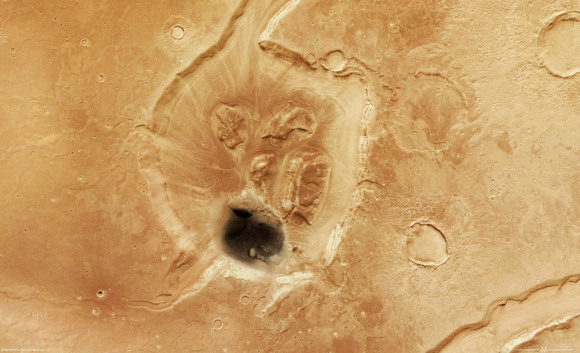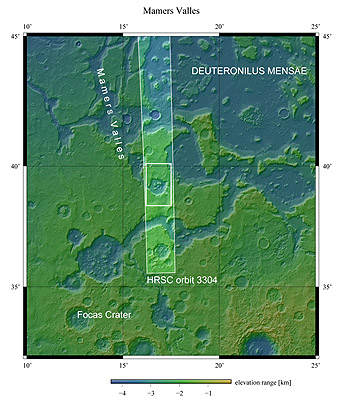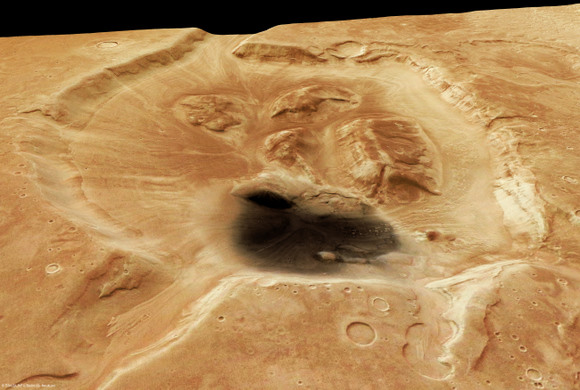The Mars Express Spacecraft captured several images of an unusual crater in the Mamers Valles area on Mars with its High-Resolution Stereo Camera (HRSC). The crater is at the end of the long, winding valley, and contains a remarkable dark area. Scientists are not certain whether the dark colored material could have formed in-situ or if it may have been transported by the wind. Some of the structures shown here are thought to be ice-rich debris flows, and they show some resemblance to block glaciers seen on Earth.

Scientists call a region like Mamers Valles ‘fretted terrain’ because it shows numerous deep and wide labyrinth-like valleys and circular depressions which often show structures formed by flowing liquid on their even floors.
The patches of rock at the center of the depression are thought to be remnants of rock that were detached from the sides of the depression and transported to the center.

This false color image shows the differences in elevation. The image was made using elevation data obtained from an HRSC-derived high-resolution Digital Terrain Model (DTM), which is used to create elevation maps on Mars. Elevation data from the DTM has been color-coded and combined with the HRSC image so that elevation data and the image itself are displayed in a single scene.

The depression is approximately 30 km wide and 1400 m deep. It lies at the south-eastern end of Mamers Valles. The data was obtained on August 5, 2006 with a ground resolution of approximately 14 m/pixel.

The images are centered at approximately 39° north and 17° east on the planet. The valley of Mamers Valles is approximately 1000 km long, running along the boundary between the northern lowlands and southern highlands in the region of Deuteronilus Mensae.
Original News Source: ESA


I think it is quite obvious this site is the launchpad of the Ark spacecraft that evacuated citizens of the Cydonia civilization from their dying planet so they could start over again on Earth. The giant scorch mark and blast radius speak for themselves!
Any ideas on what would contribute to the dark material? Is this the result of high temps at impact?
I agree with Dick Hoagland
Hmmmmm, that’s quite weird. It looks to me look sediment of dirt resting at the bottom of a pool. There even appears to be a round rock at the bottom middle of that pic, which appears to be protruding slightly above the water surrounding it.
It’s the cush site of the shuttle carrying Deanna Troi with the pilot. Don’t you remember, Picard ordered to destroy the wreckage of the shuttle with a torpedo to ensure that Armus has no means of escape?
This should refreesh your memory:
http://images3.wikia.nocookie.net/memoryalpha/en/images/thumb/5/5a/Vagra_II.jpg/180px-Vagra_II.jpg
http://www.durfee.net/startrek/images/TNG122.jpg
http://en.wikipedia.org/wiki/Skin_of_Evil
Maybe this is the Beagle 2 crash site
It appears to be burn marks. And with the outlines of the perimeter looking to have once been a lava flow from a volcanic eruption thousands of years ago. The current burn marks could indicate a recent eruption.
If this is possible then the type of volcano would be a shield type. This is only my hypothesis. Even as with earth there is ice sometimes before a volcanic eruption.
This is incredible! This looks unmistakably like a human epiglotis. There is no question that some star faring civilization tried to communicate the image of our epigloti so long ago. We are most definitely not alone. Epigloti are prolific throughout the universe!
The Face on Mars will most certainly be eclipsed by the Epiglotis on Mars. (merrily making gargling sounds)
If you look at the image from the black end furthest from your view it would seem that we are looking at an uprising oil flow that has melted the surrounding ice and the resulting water flow has passed around the central region that is now also breaking up. The centre is higher than the surrounding melt trough. Oil is much warmer as it rises from deep within the mantle. The surface, being black will also be warmer. If it was not oil, then dust would have covered the surface with the same colour as the surrounding surfaces. Also, remember oil is formed from out gassing of hydrocarbons, not from biomass deposits.
Due to the likelihood of there being liquid water close to the surface as well as oil which may be used for production of rocket fuel for a return flight, this would make a good candidate for further research.